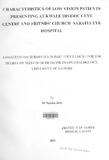| dc.contributor.author | Ndiritu, Judy | |
| dc.date.accessioned | 2013-05-25T07:09:10Z | |
| dc.date.available | 2013-05-25T07:09:10Z | |
| dc.date.issued | 2011 | |
| dc.identifier.uri | http://erepository.uonbi.ac.ke:8080/xmlui/handle/11295/25559 | |
| dc.description.abstract | Background
In most developing countries, it has been shown that causes of low vision are mostly avoidable
with timely diagnosis. and appropriate management
Data on the causes of functional low vision in patients seen at the low vision clinics of Friends'
Church Sabatia Eye Hospital and Kwale District Eye Centre is lacking but is important for
planning low vision services.
Objectives
The aim of the study was to describe characteristics of patients presenting at the Low Vision
Clinic of Kwale District Eye Centre and Friends' Church Sabatia Eye Hospital and to assess the
type of Low Vision Aid given to each patient found to have low vision.
Study Design
Retrospective Case Series
Study Setting
Friends' Church Sabatia Eye Hospital Low Vision Clinic, Sabatia District in Western Province.
Kwale District Eye Centre Low Vision Clinic, Kwale District in Coast Province.
Study Subjects
All records of new patients seen Sabatia Eye Hospital Low Vision Clinic from 151 Jan 2007 to
3151 Jan 2011, and found to have low vision as per the low vision case definition, were
scrutinized.
All records of new patients seen at Kwale District Eye Centre Low Vision Clinic from 1st Jan
2003 to 31st Jan 2011, and foundto have low vision as per the low vision case definition, were
scrutinized.
Materials and Methods
Low vision assessment sheets of patients were scrutinized and data of eligible patients collected
on a structured questionnaire and entered into a database.
Analysis done using the Statistical Package for Social Scientists (SPSS) version 17.0. A
significance level of 95% was used.
v
Results
A total of382 patient records were reviewed - 237 in SEH and 145 in KDEC Low vision clinics.
Overall Male to Female ratio was 1.6:1. Mean age of presentation overall was 23.4 years.
Maculopathy was the main cause of low vision in adults and oculocutaneous albinism In
children. Lens disorders were the second most common cause of low vision in children; while
in adults it was optic nerve disorders.
Potentially avoidable causes of low VISIOn were 43.6% in adults and 60.2% in children.
Associated disabilities were found in only a small minority of patients (2.9%). The most
frequently prescribed LV device for distance for children was the x2 telescope, while for adults it
was the x4 telescope. The most commonly prescribed LV device for near for children was the x2
dome magnifier while for adults it was the +8D spectacle magnifier. For both adults and
children, the most frequently prescribed Non-Optical Aid was reduced working distance.
Conclusions
More males than females were seen at the low vision clinics, majority of whom were adults.
Retinal diseases were the leading cause of low visiop in both children and adults. Most of the
causes of low vision in children were potentially avoidable (60.2%). Adults were more likely to
benefit from near optical aids. Most of the patients were in category 3 and 4 of low vision, and
therefore likely to benefit from low vision devices. | en |
| dc.language.iso | en | en |
| dc.publisher | University Of Nairobi | en |
| dc.title | Characteristics of low vision patients Presenting at Kwale district eye Centre and friends' church Sabatia eye Hospital | en |
| dc.type | Thesis | en |
| dc.description.department | a
Department of Psychiatry, University of Nairobi, ; bDepartment of Mental Health, School of Medicine,
Moi University, Eldoret, Kenya | |
| local.publisher | College of Health Sciences | en |

